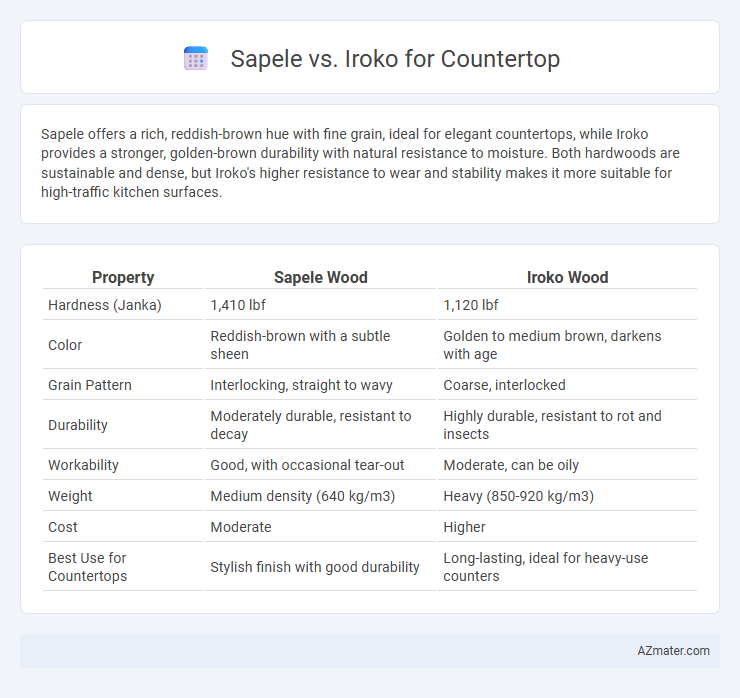Sapele offers a rich, reddish-brown hue with fine grain, ideal for elegant countertops, while Iroko provides a stronger, golden-brown durability with natural resistance to moisture. Both hardwoods are sustainable and dense, but Iroko's higher resistance to wear and stability makes it more suitable for high-traffic kitchen surfaces.
Table of Comparison
| Property | Sapele Wood | Iroko Wood |
|---|---|---|
| Hardness (Janka) | 1,410 lbf | 1,120 lbf |
| Color | Reddish-brown with a subtle sheen | Golden to medium brown, darkens with age |
| Grain Pattern | Interlocking, straight to wavy | Coarse, interlocked |
| Durability | Moderately durable, resistant to decay | Highly durable, resistant to rot and insects |
| Workability | Good, with occasional tear-out | Moderate, can be oily |
| Weight | Medium density (640 kg/m3) | Heavy (850-920 kg/m3) |
| Cost | Moderate | Higher |
| Best Use for Countertops | Stylish finish with good durability | Long-lasting, ideal for heavy-use counters |
Introduction: Sapele vs Iroko for Countertops
Sapele and Iroko are popular hardwood choices for countertops due to their durability and rich color tones. Sapele features a deep reddish-brown hue with fine interlocking grain, offering a smooth, elegant finish that resists wear and tear. Iroko is valued for its golden to medium brown color, exceptional hardness, and natural resistance to moisture and decay, making it ideal for heavily used kitchen surfaces.
Wood Origins and Characteristics
Sapele, a hardwood from West Africa, features a fine, even grain with a reddish-brown hue that darkens over time, making it ideal for elegant and durable countertops. Iroko, also native to tropical West Africa, offers a coarse texture with golden to medium brown tones and exceptional resistance to moisture and decay, commonly used in both indoor and outdoor applications. Both woods provide strength and longevity, but Sapele's refined appearance contrasts with Iroko's robust, weather-resistant qualities for countertop surfaces.
Appearance and Color Differences
Sapele wood features a reddish-brown hue with fine, interlocking grain patterns that create a rich, shimmering appearance, often displaying a satiny texture ideal for elegant countertops. In contrast, Iroko offers a golden to medium brown color that darkens with age, exhibiting a coarse, uneven grain with occasional oily texture, lending a more rustic and warm look to surfaces. The choice between Sapele and Iroko countertops hinges on whether the desired aesthetic leans toward the vibrant, polished look of Sapele or the durable, earthy tone of Iroko.
Durability and Hardness Comparison
Sapele and Iroko are both hardwoods commonly used for countertops, but Iroko offers superior durability and hardness, with a Janka hardness rating of around 1,120 lbf compared to Sapele's 1,410 lbf. Iroko is highly resistant to wear, dents, and moisture, making it ideal for heavy-use kitchen surfaces, while Sapele, though dense and durable, is slightly softer and may show wear over time. Both woods have excellent dimensional stability, but Iroko's superior hardness enhances long-term performance and scratch resistance in countertop applications.
Workability and Ease of Installation
Sapele offers a smooth grain and moderate hardness, making it easier to cut and shape for countertop installation compared to the denser and heavier Iroko. Iroko's durability and resistance to wear present challenges during tooling and fitting, requiring more specialized equipment and effort. Both woods offer good stability, but Sapele's superior workability often results in faster installation times and fewer adjustments on-site.
Resistance to Moisture and Warping
Sapele wood offers moderate resistance to moisture but is more prone to warping compared to Iroko, which is renowned for its superior moisture resistance and dimensional stability. Iroko's natural oils provide excellent protection against water damage, making it a preferred choice for countertops in humid or wet environments. While both hardwoods are durable, Iroko's enhanced resistance to warping ensures long-lasting performance with minimal maintenance.
Maintenance and Longevity
Sapele and Iroko are both durable hardwoods ideal for countertops, but Iroko offers superior resistance to moisture and decay, which enhances its longevity in kitchen environments. Sapele requires regular oiling and sealing to maintain its rich color and protect against stains, while Iroko's natural oils reduce the frequency of maintenance. Over time, Iroko countertops tend to retain their structural integrity better, making them a low-maintenance, long-lasting option for high-traffic areas.
Cost and Availability
Sapele wood is generally more affordable and easier to source than Iroko, making it a cost-effective choice for countertops. Iroko, known for its high durability and weather resistance, tends to be pricier due to its slower growth rate and limited availability. Both hardwoods provide excellent strength, but Sapele's more abundant supply often results in lower market prices and faster procurement times.
Environmental Impact and Sustainability
Sapele and Iroko are both hardwoods commonly used for countertops, but their environmental impacts differ significantly. Sapele, sourced primarily from West Africa, faces concerns related to deforestation and habitat loss due to illegal logging practices, whereas Iroko, also native to West Africa, is often praised for better availability and greater sustainability when harvested from well-managed forests. Choosing certified wood from reputable suppliers is crucial to minimize ecological footprint and promote sustainable countertop options.
Best Applications and Final Recommendation
Sapele offers a smooth, fine grain with a reddish-brown hue ideal for decorative countertops in kitchens, bars, and furniture tops requiring a refined appearance. Iroko, known for its durability, resistance to moisture, and golden to dark brown color variations, suits high-traffic areas or environments prone to humidity, such as bathrooms and outdoor countertops. For a balance of aesthetics and heavy usage, Iroko is recommended for durability and moisture resistance, while Sapele excels for elegant, indoor decorative applications.

Infographic: Sapele vs Iroko for Countertop
 azmater.com
azmater.com